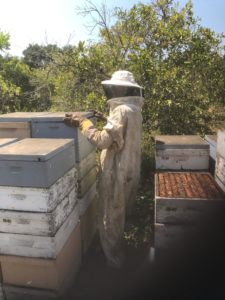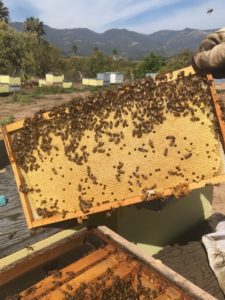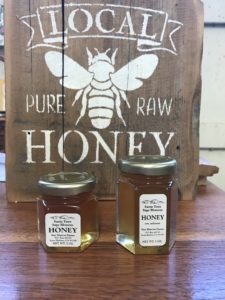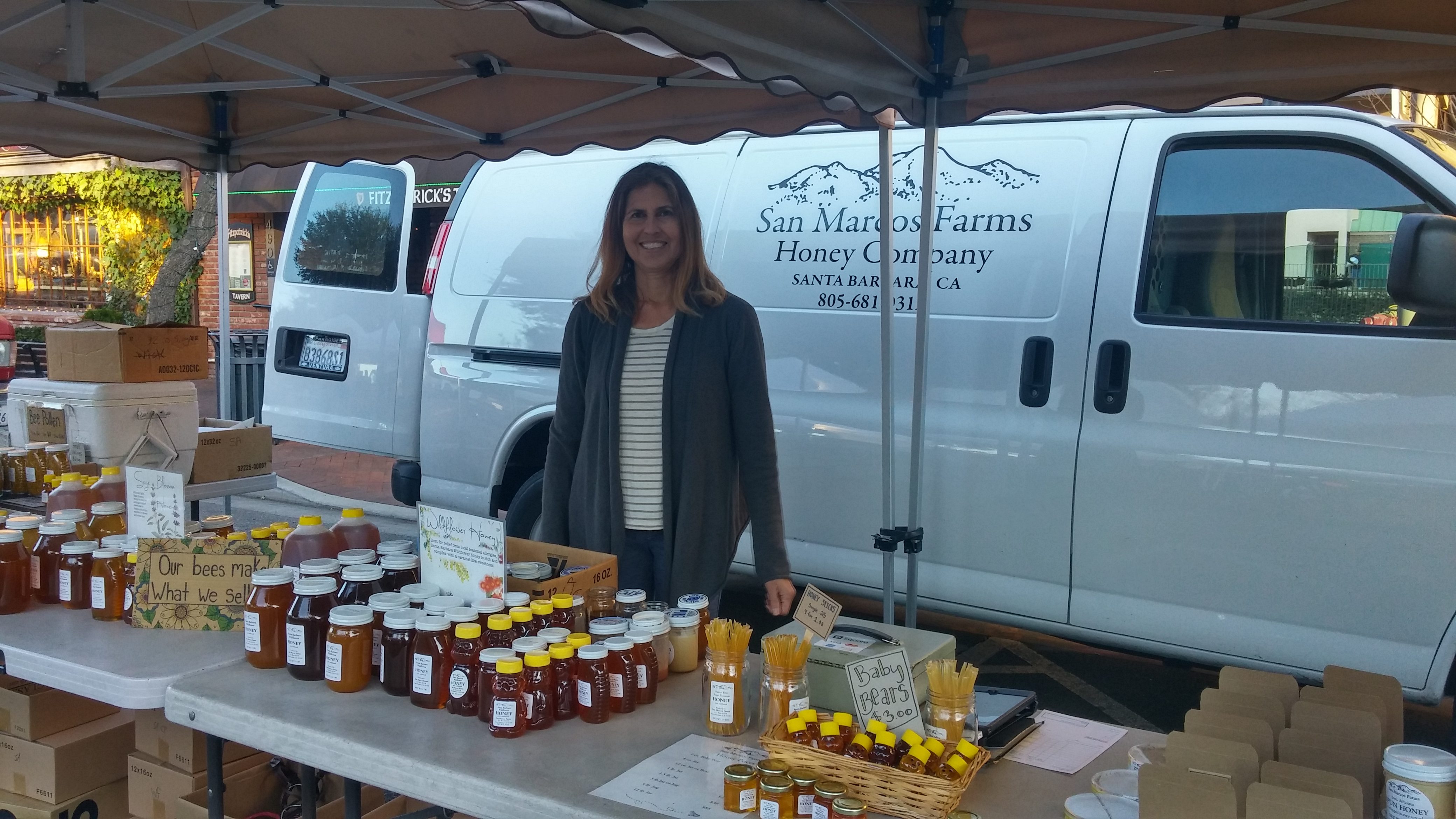By Pamela Dozois
Contributing Writer
“Some say that unto bees a share is given of the Divine Intelligence,” according to the ancient poet Virgil.
Donald and Anne Cole, the owners of San Marcos Farms, agree. They are beekeepers who produce honey, bee pollen and beeswax and also have a crop pollination service.
“My father raised bees in the late 1960s and was considered a hobbyist with a small number of hives,” Don said. “Beekeeping dates back thousands of years.”
“There have probably been more books written on bees and beekeeping than on any other subject,” Don said. “There is a 15,000 year-old cave painting in Spain which depicts a human figure robbing honey out of a beehive. Interestingly enough, honey is the only food product created by an insect that humans eat. There is a lot to be learned about bees and honey. “

Elias Cole, a next-generation beekeeper, tends hives in Ojai.
The Coles have continued the family tradition. Their two sons, Jesse and Elias, work with the bees to create the various products made from honey bees’ wax and propolis, which is also known as “bee glue.” They have been working at the family business since before they were teenagers and it has become their full-time pursuit.
The family is considered small-scale beekeepers with fewer than 1,000 hives.
They keep hives in both the Santa Ynez Valley and Goleta, and they move them from area to area according to the time of year, the rainfall, and the timing of blossoms.
“We move our hives when the timing is just right,” Anne said. “In February the bees pollinate the almonds, gathering nectar from the flowers on the almond trees. In March and April the bees are then moved to areas where oranges and avocados are in bloom.”
According to Cole, bees can travel up to three miles, collecting nectar from up to 2,000 flowers a day. Ninety percent of all flowering plants require assistance from pollinators.
Bees identify their own hive by its subtle pheromone scent, which humans cannot detect. Should a bee from another hive enter a neighbor’s hive, it will be dispatched.
“Diversity of food sources keeps the bees healthy,” Don said. “When the flowers are blooming, nectar and pollen is plentiful. Beekeepers refer to this as the Honey Flow. This is the time the beekeeper places new boxes on top of the hive full of empty combs.”
Coastal honey comes from avocados, sage, wildflowers, bottle brush, eucalyptus, willows and a myriad of other blooms in that area. Interior honey comes from sages, wildflowers, sumac trees, toyon, native plants, buckwheat, and whatever else is growing in that region.
When the bees have filled up each individual comb and completed drying out the nectar’s excess moisture, they cover each comb with a bit of wax, Anne explained.
“When it comes time to extract the honey, we remove the combs, then remove the wax layer and place them in a honey extractor, which spins the honey out of the comb. The honey then travels through a pipe and into a tank, ready to be pumped up into 55 gallon barrels.” She said.
“Raw honey, also called Cold Packed, is the honey which goes directly from the barrel into the jar,” she added. “Regular raw unfiltered honey is gently warmed, strained and then put into jars. We do this at our Honey House in Goleta.”
Each season, the Coles hold back a certain amount of honey from year to year to ensure that honey will always be available to their customers in case of a poor production year.

The eggs, larvae and pupae of honeybees develop in a brood frame.
“Honey is a wonderful food,” said Don. “Raw honey contains disease-preventing and disease-fighting flavonoids. Raw honey contains both propolis and bee pollen so you get the benefits of those two natural powerhouses as well. It has been scientifically proven to help with allergies, sleep problems, coughs, and wound healing. It is a natural energy source, an antioxidant powerhouse.”
“Historically, beekeepers only had to contend with a few bee-related diseases. But today bees face greater challenges such as the Varroa Mite, which is a huge problem now, and the Trachial Mite, which is also pretty serious,” Don added. “Beekeepers try to treat the hives with non-toxic substances, which kills the mites but doesn’t harm the bees or humans. Numerous viruses are spread by these mites, which get inside the shell of the baby bees and destroy them. These mites also ride on the top of the bees and suck the blood from their hosts. These viruses are thought to contribute to colony collapse disorder, which is when hives mysteriously die out.”
“Drought also plays into the demise of the bees as well,” said Anne. “Rainfall patterns also affect the honey production, but sometimes in a positive way. Bees take advantage of every little niche. In January of this year rain provided an abundance of eucalyptus flowers, which the bees took advantage of for wintertime nectar.”
“Drought years are difficult for bees,” continued Anne. “August is usually a dry month. When we remove the extra honey from the hive we always leave enough honey for the bees to get by until the next rainy season. If the bees are low on honey we will feed them sugar to keep them going. Sugar is not overly nutritious but it does sustain them. But we never feed our bees sugar in order for them to produce honey.”
“Big chemical corporations play havoc with the well-being of the bees as well. Bees are bio-indicators. They are like ‘the canary in the coal mine.’ Pesticides and fungicides are lethal to bees and other pollinators, and the chemical companies know this, but mostly ignore the facts,” Don said.

San Marcos Farms’ honey is available every Wednesday afternoon at the Solvang Farmer’s Market.
Domestic honey is different from commercial honey purchased in stores. Most commercial honey is adulterated, heavily processed and may contain antibiotics, according to Food Safety News. It may also be chemically refined, and much of it comes from China and other foreign countries.
Excessive heating destroys the natural enzymes, vitamins and minerals and eliminates much of the nutrients found in domesticated honey. The filtering and processing eliminate many of the beneficial phytonutrients, including pollens and propolis.
“If you want to attract bees into your garden and help out our bee colonies, they love rosemary, lavender, anything from the mint family like basil, or from the mustard family like arugula,” said Don. “And keep your garden fungicide- and insecticide-free.”
San Marcos Farms sells its honey at the Solvang Farmer’s Market and at two farmer’s markets in Santa Barbara. A line of their honey can also be found at El Rancho, New Frontiers and the Vin Hus in Solvang, and at various outlets in Los Olivos as well as in Santa Barbara at Lazy Acres, Lassens, Tri County Produce, and other establishments.
The farm also produces salve, lip balm, and candles made from 100 percent beeswax, which is clean-burning and nontoxic.
For more information, call 805-681-0312 or email info@sanmarcosfarms.com.






